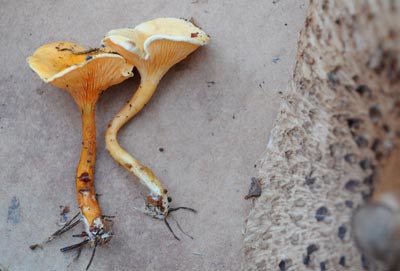The miller. A type of edible mushroom with a slightly unsual smell and one which is easily confused with other, poisonous, clitocybe mushrooms.

False chanterelle. As its name implies, this masquerades as a chanterelle but, instead of the egg yellow of the chanterelle, this is a darker orange and sometimes with a graded cap, dark at the centre and becoming lighter towards the edges. The false chanterelle is found in woodland, particularly under pines. It is edible, but is rather bitter and tough and may cause indigestion. It is easily confused with other mushrooms which are poisonous, so especial care must be taken.

False chanterelle. As its name implies, this masquerades as a chanterelle but, instead of the egg yellow of the chanterelle, this is a darker orange and sometimes with a graded cap, dark at the centre and becoming lighter towards the edges. The false chanterelle is found in woodland, particularly under pines. It is edible, but is rather bitter and tough and may cause indigestion. It is easily confused with other mushrooms which are poisonous, so especial care must be taken.
Spotted flounder. A flounder found in the Mediterranean. These fish are best filleted and fried. Is also a name for the scaldfish.
False morel mushrooms. They are deadly poisonous if not cooked, closely resembling real morel mushrooms, being wrinkled and brown in the same way. However, morel mushrooms are symmetrical while false morels are irregular in shape and look like a brown brain, while true morels are more like a sponge. True morels have hollow stems while those of false morels are solid. Be careful to check each of these features before attempting to eat one. They have a fine flavour and are generally parboiled. They are popular in Nordic countries and in Finland especially.